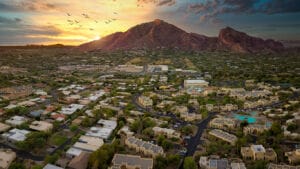For years, Arizona’s cities have been revitalizing their downtowns by bolstering the arts, installing public infrastructure like the light rail and enticing a plethora of unique, private development projects. It’s no question that Downtown Mesa has been on the receiving end of these efforts, as light rail and the Mesa Arts Center have transformed the area. Now, Downtown Mesa is set to receive another transformation after Caliber, The Wealth Development Company purchased 100,000 square feet of property in the heart of downtown.
Caliber’s $7.625 million purchase consists of eight historic buildings along Main Street between Country Club Drive and Center Street. The buildings are just a short walk from the light rail, connecting the properties to the entire Valley.
Caliber has plans to renovate the interiors and exteriors of these buildings by removing stucco facades and restoring the historic roots of these properties. There are also plans to create a rooftop restaurant on the The Newberry building Caliber purchased.
The basement spaces and old brick within these buildings lend themselves to unique and interesting development ideas for new restaurants and entertainment spaces, says Jennifer Schrader, president and co-founder of Caliber.
Currently, Schrader says there isn’t a whole lot to do in Downtown Mesa. Caliber wants to add options to the area through its redeveloped properties and create a setting where visitors will want to spend an entire day in Downtown Mesa.
“I hope people really fall in love with the community again,” Schrader says. “Mesa has an opportunity to really create a good family setting, somewhere where people will want to raise their kids, will want to spend time and not be so transient anymore.”
Mesa Mayor John Giles is excited to see Caliber’s plans for Downtown Mesa. Giles has played a role in much of the public investment into Downtown Mesa since he was a councilman in the late 1990s, paving the way for private investment like this.
Giles remembers when Downtown Mesa was “embarrassing” due to the area’s ghost town atmosphere, but he worked to bring the $100 million Mesa Arts Center and the light rail, both of which made a dramatic change to the area.
“By luck and by chance and a lot of hard work, this Downtown Mesa is what people want,” Giles says. “We set this stage now, for creating this environment people want.”
Giles says it’s great to see private investment from Caliber that will help further transform the Downtown Mesa area, making it more attractive for future employers and private investment.
Caliber’s developments could also bolster Mesa’s efforts of bringing ASU into Downtown Mesa as well, Giles says. He say economic developers have to make areas around universities attractive for students, and public investment on things like the light rail and the Mesa Arts Center are one part of that.
“We also need the business community infrastructure to create an environment that’s welcoming and attractive for people,” Giles says.
Caliber will create these attractive environments as it brings the historic vibe back to Downtown Mesa. All eight of the buildings Caliber purchased were built between 1910 and 1954.
If you were to walk by each of these buildings now, it would look like the building are much more modern, but Caliber will be transforming the buildings in the coming months, says Roy Bade, executive vice president of commercial acquisitions and development at Caliber.
The purchased buildings have a lot of character, Bade says. In one of the stores, Caliber began to remove some of the plaster on the walls, revealing an old painting from when the store was a “five & dime,” he says.
“The great trusses in there, the wood is in incredible shape still, so we’re excited to work with Mesa and bring back some of the character,” Bade says.
One of the buildings was the old Coors distributor building, the first beer distributorship Coors set up outside of Colorado, Bade mentions.
Downtown Mesa could see these improvements and new tenants take shape over the next few months.
Bade says Caliber is currently working on getting six to eight tenants to move into the buildings, and then another three to six months would be needed for tenant improvements.
“Our goal here is for people to want to stay in downtown,” Bade says. “They don’t want to come here for breakfast or lunch. They want to stay here, live here, make it their home in downtown, versus a place to visit.”




